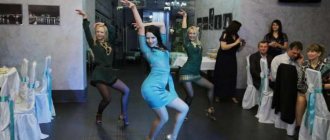Pros and cons of staging a wedding dance yourself
Preparation for a wedding dance on your own has both its positive and negative sides.
Advantages:
- If the bride and groom have nothing to do with the choreography, then they may begin to feel shy in the presence of others. As a result, you won’t be able to relax and study the composition properly. If you prepare on your own, this will not happen and you will have time to get used to the idea that you will have to speak in public on your wedding day.
- The spouses will be able to thoroughly analyze all the movements, analyze their mistakes, study the partner’s abilities and choose the combinations that are most suitable for both. Ultimately, this exciting and creative process will help fill the dance with life.
- Saving money on a choreographer.
- No need to waste time traveling to the dance studio. Rehearsals can be done at home.
- Videos with your favorite compositions are available at home, which can be repeated as many times as you like.
- By learning new things together, you will be able to become a full-fledged dancing couple on your wedding day.
Flaws:
- Serious motivation is needed, otherwise the slightest misunderstanding between the bride and groom risks resulting in the cessation of classes.
- It is difficult to calculate your own strength by choosing a composition and melody that matches the physical fitness of both participants.
- Lots of nuances to consider.
- There is no one to explain exactly what to do and how to perform certain figures. This can lead to a lack of interaction in the couple.
- Rehearsing at home does not create the right atmosphere that would charge you with energy and positivity. In such an environment, at the first failures one can easily give up.
When should you start preparing?
It all depends on the presence or absence of experience of the bride and groom.
If the newlyweds have at least a little experience, then they can learn a wedding dance in 1-2 weeks. Rehearsals in this case can be held once every 3 days for 1 hour. If there is no dance practice, then the optimal time is 1.5-2 months. During this period, the couple must select a composition, choose suitable music and learn the movements, not forgetting to form them into a beautiful dance. If you don’t plan to perform any complex lifts, turns and all other elements at the wedding, then a month is enough for preparation.
Mastering dance movements
When learning dance movements, it is necessary to gradually master them. At first, for example, you repeat the first 3 movements 5-10 times in a row, and try to do them as accurately and beautifully as possible. Then add 3 more movements to these 3 movements, and repeat a bunch of 6 movements 5-10 times in a row. And so on, the method of adding movements helps to master even very complex dances. First, it is better to learn a dance with a maximum of 8-10 movements, otherwise it will be very difficult to remember it. Then you can study longer and more complex “connections”.
Of course, it’s easier for us to learn to dance at home: no one bothers us, we don’t have to go or travel anywhere. But at home it is impossible to take into account all the subtleties of the dance. Therefore, first go to a dance school for at least a few classes. There you will better understand the technique of movements and the learning process itself. If you don’t have such an opportunity, then your home is perfect for learning to dance. The main thing is music, a mirror and video dance lessons (which can be found on the Internet or on disk).
Which wedding dance to choose
The dance style should be chosen taking into account the following:
- Your wishes.
- The character of both partners.
- Physical training.
- The presence or absence of dance experience.
- Time remaining until the holiday.
- The style of the wedding itself, for example, if it is classic, then Latin will not be entirely appropriate.
- Places where the banquet is planned to be held.
- Wedding dress.
Waltz
The most popular dance of newlyweds is the waltz, which almost all couples can perform. It comes in 4 types - Viennese, slow (baston), tango and figure.
Those who have at least some experience in choreography can pay attention to the Viennese waltz , which requires endurance, flexibility and plasticity from the performers.
Baston , being elegant and discreet, is more suitable for romantic couples.
Tango is the solution for passionate individuals who want their first dance to be remembered for a long time.
The simplest, but at the same time beautiful movements are characteristic of the figure waltz . It is especially relevant when the bride plans to get married in a fluffy wedding dress with a wide crinoline, and the groom in a classic suit.
Here is an example of a classic Viennese waltz:
Latina
For expressive people, the ideal choice would be fiery salsa and bachata, passionate paso doble and reggaeton, romantic rumba and spectacular cha-cha-cha.
You don’t need to be a professional to perform their basic movements, turns and steps beautifully. They will allow the newlyweds to show their guests the whole range of feelings that fill both of them.
It is very important that in this case, if one of the partners forgets some figures at the wedding, you can calmly improvise. There are no strict requirements for clothing and shoes here - comfortable low-heeled shoes, a dress for the bride, and an elegant suit for the groom - that's all you need!
This video shows an example of a cha-cha-cha wedding dance:
Mix
Fans of the unusual can be offered to mix movements from different styles - classic, Latin, retro. From the first it will be beautiful to take rotations, from the second - steps, and from the last - unusual supports.
This mix will really surprise the guests and add a special touch to the wedding. To be even more original, it’s just right to use music that matches their tempo for different figures, which will beautifully emphasize the transition from one style to another.
This is what the wedding mix looks like:
Retro
Boogie-woogie, elegant foxtrot and extreme rock and roll - these dances can be easily choreographed if the groom is tall and strong, and the bride is small and thin. In this case, you will need to do a lot, and sometimes very complex, supports.
Another obstacle will be the need to constantly be in motion, because such dances are based on jumping, circling, and various transitions. But they are relevant only if there is free space in the banquet hall.
Wedding dance in the style of the 20s:
What song to perform the first wedding dance to?
It’s worth looking for suitable music for dancing after choosing it. For ballroom performance, the most successful compositions will be the following:
- Sin Ti – Olga Tanon (samba)
- Tango_Forte – Duplex_Inc (tango)
- Am Who I Am – Lara FabianI (rumba)
- Vom Tod – Das Lied (paso doble)
- Obsession – Aventura (salsa)
- Abreme la Puerta – Antony Santos (bachata)
- Ain't Nothing W – Robert Randolph & The Family Band (jive).
The following melodies will help you waltz beautifully:
- My affectionate and gentle animal – Zara
- Blut – Wiener
- Hfchelbels Cannon – Louis Clark
- Sans voir le jour – Enrico Macias
- Baston - Alexander Rosembaum.
Those who choose a retro style production should listen to the following compositions:
- Angels – the Baseballs (rock and roll)
- Jailhouse Rock – Elvis Presley (boogie-woogie)
- Detroit Swing City – Liberation Records (foxtrot)
- The Great Gatsby – Gunther Noris
- Candyman – Christina Aguilera.
Having chosen the “mix” style, it will be interesting to combine musical compositions from the list of retro, Latin and classical.
What to consider when choreographing a dance
Room. First of all, attention is paid to the space that will be allocated for this.
If the area is small, then you won’t be able to waltz along it as needed, moving from side to side. In this case, it is more appropriate to come up with some more compact movements. A dance with high supports, typical of Latin and rock and roll, can be ruined by low ceilings in the room. Thus, the bride will not be able to jump into the groom’s arms, which will lead to not all elements being completed.
Floor. The material from which the floor of the hall is made is also of great importance. It will be very difficult to navigate if it is tiled. In this case, you should think about comfortable shoes without heels, which are not suitable for all dance styles.
If the flooring is parquet, then you can safely take figures from Latin, waltz, and retro. But since it can creak, it is better to rub the shoes of both partners with special compounds. Also, when dancing on it, there is a high risk that the newlyweds will lag behind each other due to poor gliding.
Shoes. It is better to exchange the bride's wedding shoes for a spare, stable pair. These can be ballet shoes, models with wedges or heels.
To avoid injuring your partner due to inexperience, it is better to avoid high heels. You should not choose them even when there is a small difference in height between the newlyweds, so that the partner does not end up taller. In this case, it will be very difficult to perform complex choreographic elements.
Guests. The location of the guests must also be taken into account. If the tables are placed on one side, then it is unacceptable for the couple to turn their backs to the audience. Then the steps should be taken from left to right or in the other direction. When placing them around the entire perimeter of the hall, you need to select circular movements so that everyone can see the bride and groom.
Photo and video shooting. Don’t forget about the work of a videographer with a photographer. In order for them to have the opportunity to capture the heroes of the occasion in an interesting and high-quality manner, they need to know in advance about their location in the banquet hall. But usually photography takes place from the right or left side.
Duration. A wedding dance usually lasts no longer than 2-3 minutes. For untrained performers, spinning on the floor for longer will be difficult - they will experience shortness of breath and begin to sweat. It won’t take long for the wedding dress to deteriorate, the style of which also plays an important role in the staging of the wedding dance.
Cloth. If the outfit is too loose, then you can get tangled in it and fall. It will also be inconvenient to support the groom when the bride needs to be circled and picked up.
However, too narrow long models are not an option, since it will be difficult to move freely around the hall in them. This way you won’t be able to repeat either the graceful swings of your legs or the sharp transitions in a waltz. In this case, the dance risks turning into standing still.
A short wedding dress gives complete freedom of imagination, allowing you to fulfill absolutely all the planned elements.
Stages of creating a dance number
Creating a DanceMany music directors create interesting dances on their own. Meanwhile, they often cannot practically translate their plans into the appropriate form.
— When starting to create a particular dance, the leader must, first of all, choose an interesting plot.
— If a folk dance is created, it is necessary to preserve its folk flavor and at the same time select such forms and elements of movements that would be accessible for children to perform. It is recommended to create folk dance with elements of play.
— Having chosen the plot and determined the nature of the dance, they select musical accompaniment for it. The concept of a choreographic work, its content and mood must correspond to the music. There are times when poorly chosen music detracts from the quality of a well-conceived dance.
— It is best to select a completed piece of music for production. At the same time, it is not recommended to get carried away with a large number of different melodies, as this deprives the musical accompaniment of a single content necessary for the dance.
— Each production should have the following sections: the beginning, the development of the dance action, the culmination of the dance and the denouement.
— After the preparatory work, the director begins to create the composition of the dance - its design and selection of movements. In this case, you need to ensure that the beginning of the musical phrase coincides with the beginning of a new construction. This does not mean that the formations should change for every musical phrase. Their change depends on the plan of the leader.
— When working on the selection of appropriate musical accompaniment, on the overall composition, you need to imagine the future dance in all its details: character, development of action, individual formations, transitions, movements.
— Various figures (circle, stars, lines, etc.) are performed for 1-8 bars, and the last two bars, and sometimes an entire musical phrase, can serve as a transition to a new figure.
— Each dance has a certain duration. So, a dance of one or two performers lasts about 2 minutes, four to six – 3-5 minutes, a mass dance – 5-6 minutes. This must be remembered in the process of creating a dance, because... a long dance tires spectators and performers, becomes monotonous and uninteresting.
Dance performance
—
Before you start staging a particular dance, you need to thoroughly understand its content and character, as well as perfectly study all its movements.
— When starting to learn a folk dance, the leader briefly tells the young performers its content, invites them to listen to music, and shows sketches of costumes and decorations.
“Only after this can we begin production.” First of all, children learn all the movements that make up the dance to music. It is recommended to study the movements first at the barre, and only then, when they are mastered, improve them in the middle of the hall.
— If the dance movements are complex, it is best to learn the movements of the legs first, and then gradually practice them together with the movements of the arms, head, and body.
-For simultaneous and accurate execution of movements to music, the leader first loudly and clearly pronounces “and” (counting the last eighth bar), the music director begins to play (or the phonogram is turned on), and the children perform the proposed movements.
-When all the dance movements have been studied, you can begin to learn figures and formations. First, they learn the introduction to the dance, then one or two figures (depending on their complexity). Learning in parts is repeated two or three times. At this time, the leader makes appropriate comments to the children and corrects their mistakes. Next, learn the following figures, each separately.
- If one part of the dance is very difficult for the performers or very simple, the leader can change the figures or movements without changing the composition of the dance as a whole.
- Having finished the choreographed work, the leader repeats the learned part of the dance with the children two or three times, without making any comments to them. This helps to better remember the sequence of formations and movements.
— After the dance is learned, its individual parts are practiced. To do this, the dance is repeated with stops. The manager points out mistakes to the performer and helps to correct them.
- When the children have mastered all the dance movements well, completed the sequence and alternation of figures, they can begin to finalize the dance.
— In mass dances, one should strive for consistency and unity of performance. It is also necessary to carefully ensure that the dance pattern (circle, lines, columns, stars, etc.) is performed evenly and clearly, the distance between all dancers must be the same, and all group movements must be performed simultaneously.
— Having completed the general dance routine, you should work on its expressiveness, the correct manner of execution, and the movements of the legs, arms, body and head characteristic of this dance.
— The leader must ensure that the dance is performed in a certain mood (fun, cheerful, lyrical) depending on its content.
- If the dance is performed on stage, it is necessary to teach children not to leave the stage immediately after the end of the dance, but to stand in place for a few seconds, bow to the audience and go backstage in an orderly manner through the door of the music hall).
Dance recording
To help music directors and choreographers, repertoire collections with recordings of dances are published. They introduce leaders to various folk dances, their basic movements and formations.
A dance recording usually consists of four parts.
— The first part describes the content of the dance, its characteristic features, manner of performance, costumes, and number of performers.
— In the second, the composition of the dance is given, indicating the movements and pattern, the number of beats in each figure.
— In the third, dance movements are described.
- In the fourth - musical accompaniment indicating the size and tempo.
— In drawings and diagrams the following symbols are used: Boys: face
— The direction of movement of the dancers is indicated by an arrow, the path of progress is indicated by a dotted line.
— To facilitate the analysis of the dance composition, drawings and drawings are attached to the recording, which help to correctly understand the direction of movement of the performers and their formation on stage.
— Dance movements are described in combination with music. The music for each dance has its own time signature. If the size is 2/4, then his count will be: “one”, “two”; 3/4 - “one”, “two”, “three”; 4/4 – “one”, “two”, “three”, “four”. A quarter is made up of two eighths. Therefore, every second eighth is determined by the “and” count.
— The description of the movements indicates at what quarter or eighth beat the dance movement is performed.
-If the movement begins on the beat, then it is called off-beat. For example, a polka with forward movement. Musical size 2/4. takt – jump on the left leg, bring the right leg forward and slightly raise it. On “one-and-two” - step your right, left, right foot forward and slightly raise your left leg above the floor. But “and” - jump on the right foot, bring the left foot forward, etc.
— In the description of each dance movement, when recording dances, the initial position of the leg from which the movement begins is determined.
— Starting to analyze the recording of the dance, the leader must carefully read the introductory part and description of the dance, clearly imagine its content, then analyze the recording of all the dance movements that make up the dance.
— Having studied all the movements, you can begin to analyze the composition of the dance. To do this, it is advisable to make a dance diagram: divide a sheet of paper into two parts, write down the movement of the participants on the stage (drawing of the dance) with symbols on the left, and the name of the dance movements and the number of bars of music on the right. This working scheme gives a complete picture of the direction of the dancers' progress.
Public lesson
—
A well-organized open lesson has great educational value. It is a kind of report on the work done by the children and demonstrates their successes. Children willingly prepare for an open lesson and, as a rule, show good results.
— An open lesson is a demonstration of the work of the entire team. It is recommended to give an open lesson only when children study regularly and have achieved certain successes.
— Experienced choreographers invited to the lesson evaluate the work of the teacher and give valuable advice to help improve the work of the circle.
— It is impossible to recommend a detailed plan for an open lesson, since it depends on the level of preparedness of the group. The plan is drawn up by the circle leader.
Concert report
—
At the end of each quarter, all groups take part in traditional reporting concerts in front of parents.
-The concert-report is held in a solemn atmosphere and must be well organized.
-The repertoire of the reporting concert is varied. But, basically, this is a display of dances learned during the reporting period, dance studies that have a finished form, etc.
-It is recommended to combine the report of the choreographic circle with the report of other circles (vocal, theater, etc.). this will decorate the concert, give it greater solemnity and give the dancers the opportunity to change clothes for the next dance.
-During the concert, you need to achieve exemplary discipline for the children, strictly adhere to the program, and make sure that there is no fuss while changing clothes.
-After the concert, children must carefully fold their costumes and hand them over to the teacher.
How to organize rehearsals correctly: useful tips
Here are some useful tips to help you organize your rehearsals correctly:
No more than 3 days , otherwise the memorized movements may be forgotten.
They must be carried out
in shoes and clothes that are as similar as possible to what will be at the wedding.
The groom should wear a suit and shoes, the bride, if a wedding dress with a wide bottom is chosen, should wear a corset and a skirt with a petticoat and rings. It is better to do the same in the case of a narrow model, which takes time to get used to. Don’t forget about the train, which requires you to rehearse while constantly holding something in your hand. If you really want to learn how to dance beautifully, then you must work on your mistakes. Each rehearsal should be videotaped. And the next lesson should begin with the analysis of the video - steps, turns, lifts, eliminating the mistakes made. At the same time, it is very important to imagine that every workout is an appearance on stage.
These are the features of independent preparation of a wedding dance, if taken into account, you will be able to adequately cope with the task.
Before you learn to dance, choose a direction
In order to really learn to dance well, you need to practice as much as possible (as with anything else). If you are learning dances with a large and complex set of movements, then the more you repeat a particular dance, the better you will remember it and hone your skills. In order to learn to dance at home, you need to decide on the direction that is closer and more interesting to you.
To do this, just watch a video of dancing. Directions, of course, can be mixed, but first it is better to master the movements of one type of dance, and then start learning a new one, otherwise you will simply get confused.
The main principles of dance training:
- accuracy of movements performed;
- repetition rate;
- gradual mastery of movements;
- the ability to “hear” music.
These are, perhaps, the basic rules that should become the basis for you to competently master any type of dance.











